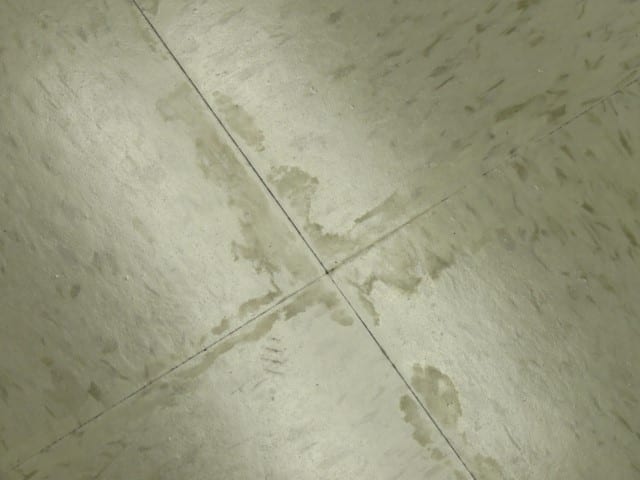What are Plasticizers and Why Do They Migrate?
Installation
By Gary Sheidker
Most resilient flooring products contain plasticizers. A general rule is the more flexible the vinyl flooring is, the higher the plasticizer content. Photo: Gary Sheidker.
Plasticizer migration is a common cause of flooring failures. Plasticizers can come from the flooring, sound control underlayment, maintenance products and even some concrete substrates. These plasticizers can attack the polymers in some adhesives causing them to degrade over time.
Plasticizers in Flooring
Most resilient flooring products contain plasticizers. The specific type and quantity can and will vary from product to product. A general rule is the more flexible the vinyl flooring is, the higher the plasticizer content. For instance, VCT will crack when you bend it without heating it first. This is because VCT is primarily limestone and is not heavily plasticized. Heterogeneous sheet goods with a felt or mineral back provide a barrier that will prevent the plasticizers in the vinyl portion of the flooring from attacking the adhesive below them.
LVT/LVP, homogeneous sheet goods, vinyl treads and other vinyl backed products are all very flexible and can emit plasticizers. These plasticizers can attack non-plasticizer resistant adhesives. Even if you are using a plasticizer resistant adhesive, the plasticizers from the flooring can break down old adhesive residue or other contaminations under the new adhesive. Which is one of the reasons adhesive manufacturers require the substrate to be free of contamination prior to installation of resilient flooring.
I have seen too many failures where a flooring installer used a non-plasticizer resistant adhesive like clear thin spread under LVT/LVP and the floor failed over time. This is because a clear thin spread adhesive is designed for use with VCT which is not heavily plasticized.
Broadloom adhesives are typically not plasticizer resistant and are vulnerable to damage from plasticizer migration. This is why it is critical to remove or encapsulate old adhesive residue prior to installing resilient flooring. Encapsulation is only an option if substrate moisture is not an issue.
LVT/LVP, homogeneous sheet goods, vinyl treads and other vinyl backed products are all very flexible and can emit plasticizers. Photo: Gary Sheidker.

Plasticizers in Sound Control Underlayment
There are many different sound control underlayment products on the market. Underlayment made from Ethylene-vinyl acetate (EVA) and expanded vinyl underlayment products are heavily plasticized. Most EVA underlayment products have a layer of plastic to prevent the plasticizers from leaching out.
There are also irradiated cross-linked polyethylene foam (IXPE), mechanically frothed urethane, and regrind rubber which have little to no plasticizer content. When installing flooring over plasticized underlayment products, a plasticizer resistant adhesive is essential. These backings are also used as an attached cushion under rigid core flooring products like SPC and WPC.
Plasticizers in Maintenance Products
I have seen pressure sensitive adhesive that is plasticizer resistant attacked by heavily plasticized wax stripers. Unfortunately, these stripping products are packaged in concentrate form, which are typically diluted on site by the maintenance crew. If the maintenance crew decides to use a high concentration of a plasticized wax stripper to speed up the process and the stripper reaches the adhesive, it can cause a failure.
This is particularly an issue for non-plasticizer resistant adhesives like clear thin spread. Please research and recommend the correct maintenance products to your customer for the flooring you are installing. This simple step can save you an expensive headache in the future.
Plasticized Concrete
This is a relatively new issue for the flooring industry. We are starting to see this from newer concrete slabs that contain super plasticizers. These super plasticizers can gradually leach out of the slab and attack adhesives, flooring, patch, and leveling products. It is essential that you know what is in the concrete you are installing over so you can take the proper steps to ensure a successful installation.
I recommend requesting a concrete mix schedule with all the admixtures and surface applied products used. If you have concerns about any of the components, you can contact your flooring or adhesive manufacturer and ask them to approve the system or recommend a course of action.
Research and Help
It is important that you research every component of the flooring being installed, including the substrate. If you are concerned about any of the components contact your flooring or adhesive supplier. Every flooring and adhesive manufacturer has a technical service department who can help with the best course of action to avoid a failure. At Taylor, we constantly receive questions from our customers about concrete admixtures, coatings and underlayment products. We are happy to research them or even perform tests to assure a successful installation.
Gary Scheidker, director of technical services, Taylor Adhesives, Meridian Adhesives Group, married his wonderful wife Dee in 1979 with whom he has two amazing sons, Michael and Eric. He has been in the flooring industry since 1970. In that time, he has been a flooring installer, estimator, retail salesperson, store owner, distributor territory manager, regional manager, and now Director of Technical Services with Taylor Adhesives.


